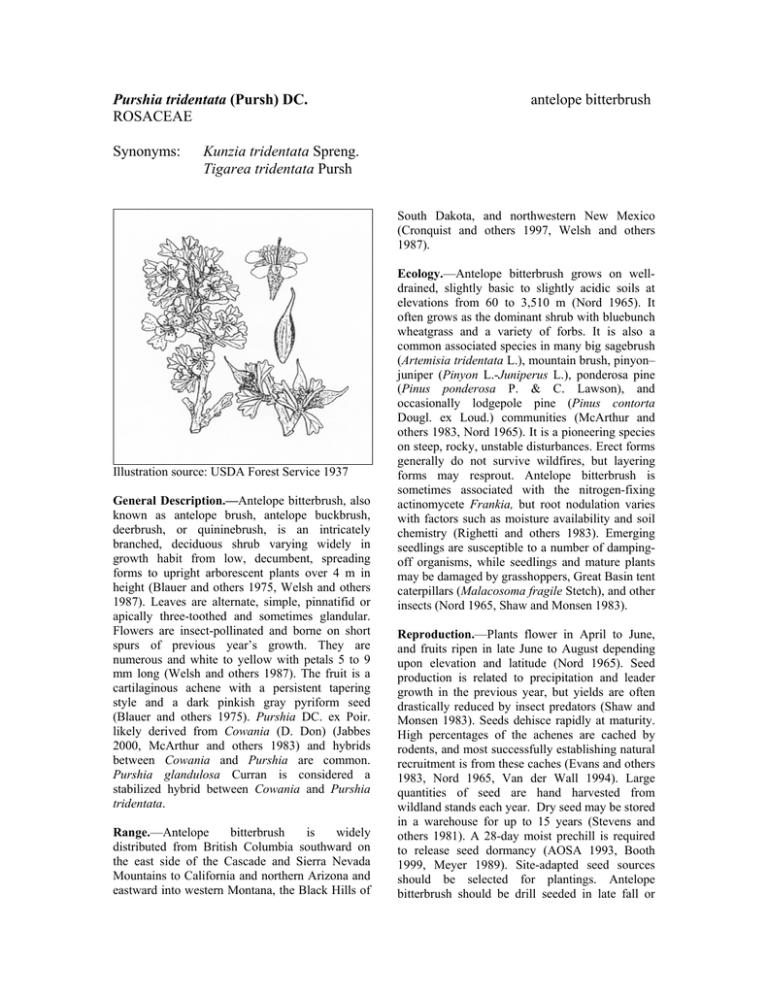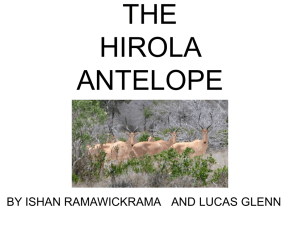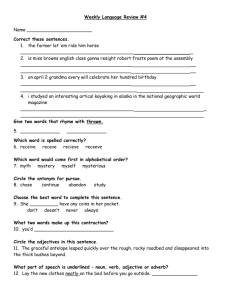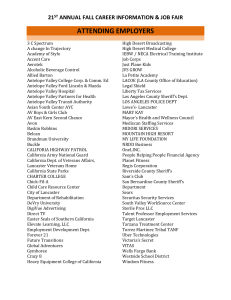Purshia tridentata antelope bitterbrush ROSACEAE
advertisement

Purshia tridentata (Pursh) DC. ROSACEAE Synonyms: antelope bitterbrush Kunzia tridentata Spreng. Tigarea tridentata Pursh South Dakota, and northwestern New Mexico (Cronquist and others 1997, Welsh and others 1987). Illustration source: USDA Forest Service 1937 General Description.—Antelope bitterbrush, also known as antelope brush, antelope buckbrush, deerbrush, or quininebrush, is an intricately branched, deciduous shrub varying widely in growth habit from low, decumbent, spreading forms to upright arborescent plants over 4 m in height (Blauer and others 1975, Welsh and others 1987). Leaves are alternate, simple, pinnatifid or apically three-toothed and sometimes glandular. Flowers are insect-pollinated and borne on short spurs of previous year’s growth. They are numerous and white to yellow with petals 5 to 9 mm long (Welsh and others 1987). The fruit is a cartilaginous achene with a persistent tapering style and a dark pinkish gray pyriform seed (Blauer and others 1975). Purshia DC. ex Poir. likely derived from Cowania (D. Don) (Jabbes 2000, McArthur and others 1983) and hybrids between Cowania and Purshia are common. Purshia glandulosa Curran is considered a stabilized hybrid between Cowania and Purshia tridentata. Range.—Antelope bitterbrush is widely distributed from British Columbia southward on the east side of the Cascade and Sierra Nevada Mountains to California and northern Arizona and eastward into western Montana, the Black Hills of Ecology.—Antelope bitterbrush grows on welldrained, slightly basic to slightly acidic soils at elevations from 60 to 3,510 m (Nord 1965). It often grows as the dominant shrub with bluebunch wheatgrass and a variety of forbs. It is also a common associated species in many big sagebrush (Artemisia tridentata L.), mountain brush, pinyon– juniper (Pinyon L.-Juniperus L.), ponderosa pine (Pinus ponderosa P. & C. Lawson), and occasionally lodgepole pine (Pinus contorta Dougl. ex Loud.) communities (McArthur and others 1983, Nord 1965). It is a pioneering species on steep, rocky, unstable disturbances. Erect forms generally do not survive wildfires, but layering forms may resprout. Antelope bitterbrush is sometimes associated with the nitrogen-fixing actinomycete Frankia, but root nodulation varies with factors such as moisture availability and soil chemistry (Righetti and others 1983). Emerging seedlings are susceptible to a number of dampingoff organisms, while seedlings and mature plants may be damaged by grasshoppers, Great Basin tent caterpillars (Malacosoma fragile Stetch), and other insects (Nord 1965, Shaw and Monsen 1983). Reproduction.—Plants flower in April to June, and fruits ripen in late June to August depending upon elevation and latitude (Nord 1965). Seed production is related to precipitation and leader growth in the previous year, but yields are often drastically reduced by insect predators (Shaw and Monsen 1983). Seeds dehisce rapidly at maturity. High percentages of the achenes are cached by rodents, and most successfully establishing natural recruitment is from these caches (Evans and others 1983, Nord 1965, Van der Wall 1994). Large quantities of seed are hand harvested from wildland stands each year. Dry seed may be stored in a warehouse for up to 15 years (Stevens and others 1981). A 28-day moist prechill is required to release seed dormancy (AOSA 1993, Booth 1999, Meyer 1989). Site-adapted seed sources should be selected for plantings. Antelope bitterbrush should be drill seeded in late fall or winter to provide overwinter prechilling. It may be seeded with other native species that are not highly competitive. Seeding failures resulting from rodent predation of seed can be avoided by seeding in late fall on fairly large disturbances that do not provide cover for the rodents (Evans and others 1983). Containerized or 1-0 bareroot seedlings are easily grown, but fungicide treatments may be required to reduce losses to damping-off organisms. Nursery stock can be planted on steep, rocky slopes that are inaccessible to seeding equipment. It establishes best if planted in early spring when antelope bitterbrush in the surrounding area is yet dormant. Herbaceous vegetation must be cleared around each seedling to reduce competition. Growth and Management.—Antelope bitterbrush seedings, plantations, and wild stands are vulnerable to heavy use by wild or domestic ungulates and predation by gophers, mice, birds, and insects. Seedlings are not competitive with weedy annuals or most introduced perennial grasses. Many mature stands are damaged by continuous and close browsing by deer and livestock. Benefits.—Next to sagebrush, antelope bitterbrush is probably one of the most widespread shrubs in the Great Basin region, although its prevalence has been reduced by range fires and exotic plant introductions (Mozingo 1987). It is important for a host of wildlife and provides nutritious browse and essential cover on fall, winter, and summer mule deer ranges (Plummer and others 1968). Protein content varies among populations depending upon over-winter leaf retention. New growth may also be heavily used in spring and summer. Because of the varied growth forms, attractive foliage, and showy flowers, antelope bitterbrush has potential as an ornamental in low-maintenance landscapes. Populations of antelope bitterbrush with distinctive attributes have been recognized and are commercially harvested and sold. Native Americans reportedly used bitterbrush as a remedy for smallpox, measles, tuberculosis, and pneumonia, and as an antiseptic for rashes and insect bites (Mozingo 1987). References AOSA [Association of Official Seed Analysts]. 1993. Rules for testing seeds. Journal of Seed Technology 16: 1–113. Blauer, A.C., A.P. Plummer, E.D. McArthur, R. Stevens, and B.C. Giunta. 1975. Characteristics and hybridization of important Intermountain shrubs. I. Rose family. U.S. Department of Agriculture, Forest Service, Intermountain Forest and Range Research Station, Ogden, UT. 35 p. Booth, D.T. 1999. Imbibition temperatures affect bitterbrush seed dormancy and seedling vigor. Journal of Arid Environments 48: 35-39. Cronquist, A., N.H. Holmgren, and P.K. Holmgren. 1997. Intermountain flora: vascular plants of the Intermountain West, U.S.A. Vol. 3, part 1. Subclass Rosidae: (except Fabales). The New York Botanical Garden, The Bronx, NY. 446 p. Evans, R.A., J.A. Young, G.J. Cluff, and J.K. McAdoo. 1983. Dynamics of antelope bitterbrush seed caches. In: A.R. Tiedemann and K.L. Johnson, comps. Proceedings: Research and management of bitterbrush and cliffrose in western North America. GTR-INT-152. U.S. Department of Agriculture, Forest Service, Intermountain Forest and Range Experiment Station, Ogden, UT. p. 195–202. Jabbes, M. 2000. Hybridization and its evolutionary consequences in Purshia and Cowania. Ph.D. dissertation. University of Idaho, Moscow, ID. 185 p. McArthur, E.D., H.C. Stutz, and S.C. Sanderson. 1983. Taxonomy, distribution, and cytogenetics of Purshia, Cowania, and Fallugia (Rosoideae, Rosaceae). In: A.R. Tiedemann and K.L. Johnson, comps. Proceedings, Research and management of bitterbrush and cliffrose in western North America. GTR-INT-152. U.S. Department of Agriculture, Intermountain Forest and Range Experiment Station. p. 4–24. Meyer, S.E. 1989. Warm pretreatment effects on antelope bitterbrush (Purshia tridentata) germination response to chilling. Northwest Science 63: 146–153. Mozingo, H.N. 1987. Shrubs of the Great Basin: a natural history. University of Nevada Press, Reno, NV. 342 p. Nord, E.C. 1965. Autecology of bitterbrush in California. Ecological Monographs 35: 307– 334. Plummer, A.P., D.R. Christensen, and S.B. Monsen. 1968. Restoring big game range in Utah. Publication 68-3. Utah Division of Fish and Game, Salt Lake City, UT. 183 p. Righetti, T.L., C.H. Chard, and D.N. Munns. 1983. Opportunities and approaches for enhancing nitrogen fixation in Purshia, Cowania and Fallugia. In: A.R. Tiedemann and K.L. Johnson, comps. Proceedings: Research and management of bitterbrush and cliffrose in western North America. GTR-INT-152. U.S. Department of Agriculture, Forest Service, Intermountain Forest and Range Experiment Station, Ogden, UT. p. 214–224. Shaw, N.L. and S.B. Monsen. 1983. Phenology and growth habits of nine antelope bitterbrush, desert bitterbrush, Stansbury cliffrose, and Apache plume accessions. In: A.R. Tiedemann and K.L. Johnson, comps. Proceedings: Research and management of bitterbrush and cliffrose in western North America. GTR-INT152. U.S. Department of Agriculture, Forest Service, Intermountain Forest and Range Experiment Station, Ogden, UT. p. 55–69. Stevens, R., K.R. Jorgensen, and J.N. Davis. 1981. Viability of seed from thirty-two shrub and forb species through fifteen years of warehouse storage. Great Basin Naturalist 41: 274–277. USDA Forest Service. 1937. Range plant handbook. U.S. Government Printing Office, Washington, D.C. 512 p. Van der Wall, S.B. 1994. Seed fate pathways of antelope bitterbrush: dispersal by seed-caching yellow pine chipmunks. Ecology 75: 1911-1926. Welsh, S.L., N.D. Atwood, L.C. Higgins, and S. Goodrich. 1987. A Utah flora. Great Basin Nturalist Memoirs 9. Brigham Young University Press. 894 p. _________________________________________ Nancy L. Shaw, Research Botanist, U.S. Department of Agriculture, Forest Service, Rocky Mountain Research Station, Boise, ID 83702 and Stephen B. Monsen, retired, Mapleton, UT 84664



